Analyzing Recent Tectonic Activity Along the Karak Wadi Al Fayha Fault System Using Seismic, Earthquake, and Remote Sensing Data
Abstract
:1. Introduction
2. Regional Geological Background
3. Data and Methods
3.1. 2D Reflection Seismic Ad Well Data
3.1.1. Seismic Data Processing and Quality Control
3.1.2. Seismic-Well Correlation
3.2. Digital Elevation Model (DEM)
3.3. Fault Mechanism Solution (FMS)
4. Results
4.1. Stratigraphic Framework
4.2. Key Seismic Horizons and Units
4.3. Seismic Characteristics of Key Reflectors
4.4. Subsurface Characteristic of the KWF
4.4.1. Seismo-Tectonic Characteristic
4.4.2. DEM and FMS Results
5. Discussion
5.1. Seismo-Stratigraphic Evolution
5.2. Seismo-Tectonic Evolution of the KWF
5.3. Late Precambrian–Latest Cretaceous Tectonics
5.4. Recent Tectonic Activity Along the KWF
6. Conclusions
- The KWF is a prominent NW-trending intraplate fault system extending from Western Karak in Jordan to Wadi Al Fayha in Saudi Arabia. This study integrates reflection seismic profiles with high-resolution DEM analysis to better understand the fault’s structural configuration and its influence on surface morphology. FMS from selected earthquakes were also evaluated to infer the prevailing stress regimes affecting the fault system;
- Seismic interpretation reveals that the KWF is a deeply rooted structure that originated as part of the Precambrian Najd Fault System. It displays a staircase fault geometry, with displacements extending from the Precambrian basement through to the uppermost Cretaceous strata. Additional fault segments disrupt formations from the Middle Cambrian to the Late Cretaceous, producing a negative flower structure and localized half-graben systems. In some areas, these faults appear to propagate toward the surface, possibly affecting younger deposits;
- Topographic analysis using multi-illumination hill-shaded DEMs shows a continuous surface expression of the KWF across both Jordan and Saudi Arabia. Field observations document slope instability, particularly in the northwestern sector, where landslides have caused infrastructure damage and led to precautionary evacuations by the Karak Municipality. While such observations may suggest recent deformation, further investigation is needed to confirm ongoing tectonic activity;
- The tectonic evolution of the KWF reflects a long and complex history. It originated during Precambrian extensional events linked to the Najd Fault System. Paleozoic fault reactivation was likely influenced by glacial loading and unloading processes, along with prolonged regional uplift. During the Mesozoic, especially from the Late Cretaceous to Late Eocene, compressional and strike-slip tectonics associated with the Syrian Arc deformation further reactivated the fault. In more recent geological time, changes in the regional stress field—beginning with the Eocene development of the Irbid Rift and continuing with the Miocene evolution of the DSTF—may have contributed to additional fault reactivation and transtensional deformation;
- Overall, this study offers new insights into the structural evolution of the KWF, emphasizing its role within the broader tectonic framework of the region. While indications of recent fault-related deformation exist, further detailed geochronological and geodetic studies are necessary to assess the current level of activity and its implications for seismic hazard assessment.
Author Contributions
Funding
Data Availability Statement
Acknowledgments
Conflicts of Interest
Abbreviations
| Abbreviation | Definition |
| DEM | Digital Elevation Model |
| DSTF | Dead Sea Transform Fault |
| FMS | Fault Mechanism Solution |
| KWF | Karak Wadi Al Fayha Fault |
References
- Gupta, R.P. Delineation of active faulting and some tectonic interpretations in Munich-Milan section of Eastern Alps—Use of Landsat imagery. Tectonophysics 1977, 38, 297–315. [Google Scholar] [CrossRef]
- Sen, D.; Sen, S. Post-Neogene tectonism along Aravalli range, Rajasthan, India. Tectonophysics 1983, 93, 75–98. [Google Scholar] [CrossRef]
- McCalpin, J.P. Chapter 9 Application of paleoseismic data to seismic hazard assessment and neotectonic research. Int. Geophys. 2009, 95, 1–106. [Google Scholar] [CrossRef]
- Field, E.H.; Biasi, G.P.; Bird, P.; Dawson, T.E.; Felzer, K.R.; Jackson, D.D.; Johnson, K.M.; Jordan, T.H.; Madden, C.; Michael, A.J.; et al. A new earthquake forecast for California’s complex fault system. In USGS Open-File Report; U.S. Geological Survey: Reston, VA, USA, 2015; pp. 2015–3009. [Google Scholar] [CrossRef]
- Gupta, R.P. Remote Sensing Geology; Springer: Berlin/Heidelberg, Germany, 2003. [Google Scholar]
- Bender, F. Geologische Karte Von Jordanien; MaßStab 1: 250,000 (5 Blatter); Geological Survey of the Republic of Germany: Hannover, Germany, 1968. [Google Scholar]
- Stern, R.J.; Johnson, P. Continental lithosphere of the Arabian Plate: A geologic, petrologic, and geophysical synthesis. Earth-Sci. Rev. 2010, 101, 29–67. [Google Scholar] [CrossRef]
- Al Hseinat, M.A.; AlZidaneen, M.; Jaradat, R.; Al-Rawabdeh, A.; Hübscher, C. Tectono-stratigraphic framework and evolution of the northwestern Arabian plate, Central Jordan. Tectonophysics 2023, 863, 229993. [Google Scholar] [CrossRef]
- Bartov, Y. A Structural and Paleogeographical Study of the Central Sinai Faults and Domes. Ph.D. Thesis, Hebrew University, Jerusalem, Israel, 1974. [Google Scholar]
- Moh’d, B.K. The Geology of Wadi Al-Buway’ija. Bull 5, Geo. Dir.; Natural Resource Athurity: Amman, Jordan, 1986. [Google Scholar]
- Powell, J.H. The Geology of the Karak Area. Bull 5, Geo. Dir.; Natural Resource Athurity: Amman, Jordan, 1988. [Google Scholar]
- Shawabkeh, K. The Geology of the Adir Area. Bull 18, Geo. Dir.; Natural Resource Athurity: Amman, Jordan, 1991. [Google Scholar]
- Bender, F. Geology of Jordan: Contribution to the Regional Geology of the World; Gebrueder Borntraeger: Stuttgart, Germany, 1974. [Google Scholar]
- Al-Zoubi, A.S. The basement faults system in the northwestern Arabian Plate, Jordan. Bull. Geol. Soc. Greece 2007, 40, 251. [Google Scholar] [CrossRef]
- Garbrecht, J.; Martz, L. Grid size dependency of parameters extracted from digital elevation models. Comput. Geosci. 1994, 20, 85–87. [Google Scholar] [CrossRef]
- Abdullah, A.; Akhir, J.M.; Abdullah, I. Automatic mapping of lineaments using shaded relief images derived from digital elevation model (DEMs) in the Maran—Sungi Lembing area, Malaysia. Electron. J. Geotech. Eng. 2010, 15, 949–957. [Google Scholar]
- Radaideh, O.M.A.; Grasemann, B.; Melichar, R.; Mosar, J. Detection and analysis of morphotectonic features utilizing satellite remote sensing and GIS: An example in SW Jordan. Geomorphology 2016, 275, 58–79. [Google Scholar] [CrossRef]
- Al Hseinat, M.A.; Al-Rawabdeh, A.; Al-Zidaneen, M.; Ghanem, H.; Al-Taj, M.; Diabat, A.; Jarrar, G.; Atallah, M. New insights for understanding the structural deformation style of the strike-slip regime along the Wadi Shueib and Amman-Hallabat structures in Jordan based on remote sensing data analysis. Geosciences 2020, 10, 253. [Google Scholar] [CrossRef]
- Stein, S. Fault plane solutions. In Structural Geology and Tectonics. Encyclopedia of Earth Science; Springer: Berlin/Heidelberg, Germany, 1987. [Google Scholar] [CrossRef]
- Sharland, P.R.; Archer, R.; Casey, D.M.; Davies, R.B.; Hall, S.H.; Heward, A.P.; Horbury, A.D.; Simmons, M.D. Arabian Plate sequence stratigraphy. GeoArabia 2001, 9, 199–214. [Google Scholar] [CrossRef]
- Bentor, Y.K. The crustal evolution of the AraboNubian Massif with special reference to the Sinai Peninsula. Precambrian Res. 1985, 28, 1–74. [Google Scholar] [CrossRef]
- Jarrar, G.; Wachendorf, H.; Zellmer, H. The Saramuj Conglomerate: Evolution of a Pan-African molasse sequence from south-west Jordan. Precambrian Res. 1991, 239, 6–23. [Google Scholar] [CrossRef]
- Jarrar, G.; Stern, R.J.; Saffarini, H.; Al-Zubi, H. Late- and post-orogenic Neoproterozoic intrusions of Jordan: Implications for crustal growth in the northernmost segment of the East African Orogen. Precambrian Res. 2003, 123, 295–319. [Google Scholar] [CrossRef]
- Powell, J.H.; Abed, A.; Jarrar, G. Ediacaran Araba Complex of Jordan. GeoArabia 2015, 20, 99–156. [Google Scholar] [CrossRef]
- Burdon, D. Handbook of the Geology of Jordan; Benham and Co.: Colchester, UK,, 1959. [Google Scholar]
- Husseini, M.I. Tectonic and Deposition Model of Late Precambrian-Cambrian Arabian and Adjoining Plates; United States Geological Survey: Reston, VA, USA, 1989. [Google Scholar]
- Husseini, M.I. Origin of the Arabian Plate Structures: Amar Collision and Najd Rift. GeoArabia 2000, 5, 527–542. [Google Scholar] [CrossRef]
- Radaideh, O.M.A.; Melichar, R. Tectonic paleostress fields in the southwestern part of Jordan: New insights from the fault slip data in the southeastern flank of the Dead Sea Fault Zone. Tectonics 2015, 34, 1863–1891. [Google Scholar] [CrossRef]
- Powell, J.H.; Abed, A.; Le Nindre, Y.M. Cambrian stratigraphy of Jordan. GeoArabia 2014, 19, 81–134. [Google Scholar] [CrossRef]
- Turner, B.; Makhlouf, I.; Armstrong, H. Late Ordovician (Ashgillian) glacial deposits in southern Jordan. Sediment. Geol. 2005, 181, 73–91. [Google Scholar] [CrossRef]
- Ruban, D.A.; Husseini, M.I.; Iwasaki, Y. Review of middle east Paleozoic plate tectonics. GeoArabia 2007, 12, 35–56. [Google Scholar] [CrossRef]
- Ziegler, M.A. Evolution of the Arctic-north Atlantic and the western Tethys–a visual presentation of a series of paleogeographic-paleotectonic maps. Memoir 1988, 43, 164–196. [Google Scholar] [CrossRef]
- Stampfli, G.M.; Hochard, C. Plate tectonics of the Alpine Realm. Geol. Soc. Lond. Spec. Publ. 2009, 327, 89–111. [Google Scholar] [CrossRef]
- Frizon de Lamotte, D.; Raulin, C.; Mouchot, N.; Wrobel-Daveau, J.; Blanpied, C.; Ringenbach, J. The southernmost margin of the Tethys Realm during the Mesozoic and Cenozoic: Initial geometry and timing of the inversion processes. Tectonics 2011, 30, 1–22. [Google Scholar] [CrossRef]
- Eyal, Y.; Reches, Z. Tectonic analysis of the Dead Sea Rift region since the Late Cretaceous based on mesostructures. Tectonics 1983, 2, 167–185. [Google Scholar] [CrossRef]
- Ron, H.; Eyal, Y. Intraplate deformation by block rotation and mesostructures along the Dead Sea Transform, Northern Israel. Tectonics 1985, 4, 85–105. [Google Scholar] [CrossRef]
- Hatzor, Y.; Reches, Z. Structure and paleostresses in the Gilboa’ region, western margins of the Central Dead Sea Rift. Tectonophysics 1990, 180, 87–100. [Google Scholar] [CrossRef]
- Eyal, Y. Stress field fluctuations along the Dead Sea rift since the Middle Miocene. Tectonics 1996, 15, 157–170. [Google Scholar] [CrossRef]
- Segev, A.; Lyakhovsky, V.; Weinberger, R. Continental transform–rift interaction adjacent to a continental margin: The Levant case study. Earth-Sci. Rev. 2014, 139, 83–103. [Google Scholar] [CrossRef]
- Garfunkel, Z. Internal structure of the Dead Sea leaky transform (rift) in relation to plate kinematics. Tectonophysics 1981, 80, 81–108. [Google Scholar] [CrossRef]
- Hofmann, C.; Courtillot, V. Timing of the Ethiopian flood basalt event and implications for plume birth and global change. Nature 1997, 389, 838–841. [Google Scholar] [CrossRef]
- Ilani, S.; Harlavan, Y.; Tarawneh, K.; Rabba, I.; Weinberger, R.; Ibrahim, K.; Peltz, S.; Steinitz, G. New K-Ar ages of basalts from the Harrat Ash Shaam volcanic field in Jordan: Implications for the span and duration of the upper-mantle upwelling beneath the western Arabian plate. Geology 2001, 29, 171. [Google Scholar] [CrossRef]
- Pik, R.; Marty, B.; Carignan, J.; Lavé, J. Stability of the Upper Nile drainage network (Ethiopia) deduced from (U–Th)/He thermochronometry: Implications for uplift and erosion of the Afar plume dome. Earth Planet. Sci. Lett. 2003, 215, 73–88. [Google Scholar] [CrossRef]
- Schattner, U.; Ben-Avraham, Z.; Reshef, M.; Bar-Am, G.; Lazar, M. Oligocene–Miocene formation of the Haifa basin: Qishon–Sirhan rifting coeval with the Red Sea–Suez rift system. Tectonophysics 2006, 419, 1–12. [Google Scholar] [CrossRef]
- Segev, A.; Rybakov, M. History of faulting and magmatism in the Galilee (Israel) and across the Levant continental margin inferred from potential field data. J. Geodyn. 2011, 51, 264–284. [Google Scholar] [CrossRef]
- Avni, Y.; Segev, A.; Ginat, H. Oligocene regional denudation of the northern Afar Dome: Pre- and syn-breakup stages of the Afro-Arabian plate. Geol. Soc. Am. Bull. 2012, 124, 1871–1897. [Google Scholar] [CrossRef]
- Faccenna, C.; Becker, T.W.; Jolivet, L.; Keskin, M. Mantle convection in the Middle East: Reconciling Afar upwelling, Arabia indentation, and Aegean trench rollback. Earth Planet. Sci. Lett. 2013, 375, 254–269. [Google Scholar] [CrossRef]
- Wald, R. Interpretation of the Lower (Southern) Galilee Tectonic Evolution from Oligocene Truncation to Miocene-Pliocene Deformation Using Geological Geophysical Subsurface Data. Ph.D. Thesis, University of Haifa, Haifa, Israel, 2016; p. 196, (In Hebrew with English abstract). [Google Scholar]
- Wald, R.; Schattner, U.; Segev, A.; Ben-Avraham, Z. Structural expression of a fading rift front: A case study from the Oligo-Miocene Irbid rift of northwest Arabia. Solid Earth 2019, 10, 225–250. [Google Scholar] [CrossRef]
- Wald, R.; Schattner, U.; Segev, A.; Ben-Avraham, Z. Initiation of Arabian Plate exposure during the Oligocene: Evidence from the Galilee, Israel. In Proceedings of the AAPG International Conference, Istanbul, Turkey, 14–17 September 2014. [Google Scholar]
- Al Hseinat, M.; AlZidaneen, M. Restraining bend deformation at the northern termination of the Wadi Araba Fault: Insights from reflection seismic data and focal mechanism solutions. Tectonophysics 2024, 887, 230456. [Google Scholar] [CrossRef]
- Bosworth, W.; Huchon, P.; McClay, K. The Red Sea and Gulf of Aden Basins. J. Afr. Earth Sci. 2005, 43, 334–378. [Google Scholar] [CrossRef]
- Bishop, T.N.; Nunns, A.G. Correcting amplitude, time, and phase mis-ties in seismic data. Geophysics 1994, 59, 946–953. [Google Scholar] [CrossRef]
- Jordan Hunt Oil Company. Jafr-01 exploration well. In Natural Resource Authority Report; Jordan Hunt Oil Company: Amman, Jordan, 1989. [Google Scholar]
- Natural Resource Authority. Jafr-02 exploration well. In Natural Resource Authority Report; Natural Resource Authority: Amman, Jordan, 1990. [Google Scholar]
- National Petrolum Company. Jafr-03 exploration well. In Natural Resource Authority Report; National Petrolum Company: Amman, Jordan, 2023. [Google Scholar]
- Drury, S.A. Image Interpretation in Geology, 2nd ed.; Chapman and Hall: London, UK, 1993. [Google Scholar]
- Lillesand, T.M.; Kiefer, R.W. Remote Sensing and Image Interpretation; John Wiley Sons: Hoboken, NJ, USA, 2000. [Google Scholar]
- Prasad, N.; Saran, S.; Kushwaha, S.P.S.; Roy, P.S. Evaluation of various image fusion techniques and imaging scales for forest features interpretation. Curr. Sci. 2001, 81, 1218–1224. [Google Scholar]
- Marghany, M.; Hashim, M. Lineament mapping using multispectral remote sensing satellite data. Res. J. Appl. Sci. 2010, 5, 126–130. [Google Scholar] [CrossRef]
- Hardcastle, K.C. Photolineament Factor: A new computer-aided method for remotely sensing the degree to which bedrock is fractured. Photogramm. Eng. Remote Sens. 1995, 61, 739–747. [Google Scholar]
- Masoud, A.; Koike, K. Tectonic architecture through Landsat-7 ETM+/SRTM DEM-derived lineaments and relationship to the hydrogeologic setting in Siwa region, NW Egypt. J. Afr. Earth Sci. 2006, 45, 467–477. [Google Scholar] [CrossRef]
- Hashim, M.; Ahmad, S.; Johari, M.A.M.; Pour, A.B. Automatic lineament extraction in a heavily vegetated region using Landsat Enhanced Thematic Mapper (ETM+) imagery. Adv. Space Res. 2012, 51, 874–890. [Google Scholar] [CrossRef]
- Pour, A.B.; Hashim, M. Structural mapping using PALSAR data in the Central Gold Belt, Peninsular Malaysia. Ore Geol. Rev. 2014, 64, 13–22. [Google Scholar] [CrossRef]
- Batson, R.M.; Edwards, E.; Eliason, E.M. Computer-generated shaded-relief images. J. Res. U.S. Geol. Surv. 1975, 4, 401–408. [Google Scholar]
- Horn, B. Hill shading and the reflectance map. Proc. IEEE 1981, 69, 14–47. [Google Scholar] [CrossRef]
- Simpson, D.W.; Anders, M.H. Tectonics and topography of the western United States: An application of digital mapping. GSA Today 1992, 2, 117–121. [Google Scholar]
- Cooper, G. Feature detection using sun shading. Comput. Geosci. 2003, 29, 941–948. [Google Scholar] [CrossRef]
- Mark, R.K. A multi-directional, oblique-weighted, shaded-relief image of the Island of Hawaii. U.S. Geol. Surv. Open-File Rep. 1992, 19, 92–422. Available online: http://pubs.usgs.gov/of/1992/of92-422/ (accessed on 10 May 2025).
- Jenny, B. An interactive approach to analytical relief shading. Cartogr. Int. J. Geogr. Inf. Geovis. 2001, 38, 67–75. [Google Scholar] [CrossRef]
- Sipkin, S.A. Estimation of earthquake source parameters by the inversion of waveform data: Synthetic waveforms. Phys. Earth Planet. Inter. 1982, 30, 2–3. [Google Scholar] [CrossRef]
- Montilla, J.A.P.; Galdeano, C.S.; Cassado, C.L. Use of Active Fault Data versus Seismicity Data in the Evaluation of Seismic Hazard in the Granada Basin (Southern Spain). Bull. Seismol. Soc. Am. 2003, 93, 1670–1678. [Google Scholar] [CrossRef]
- Havskov, J.; Ottemöller, L. Seisan earthquake analysis software. Seismol. Res. Lett. 1999, 70, 532–534. [Google Scholar] [CrossRef]
- Havskov, J.; Ottemöller, L. SEISAN: The earthquake analysis software for Windows, Solaris, Linux and MACOSX version 8.2 Manual. Seismol. Res. Lett. 2008, 70, 532–534. [Google Scholar] [CrossRef]
- Havskov, J.; Voss, P.H.; Ottemöller, L. Seismological Observatory Software: 30 Yr of SEISAN. Seismol. Res. Lett. 2020, 91, 1846–1852. [Google Scholar] [CrossRef]
- El-Isa, Z. The instrumental seismicity of the Jordan Dead Sea transform. Arab. J. Geosci. 2017, 10, 203. [Google Scholar] [CrossRef]
- Cronin, V. A Primer on Focal Mechanism Solutions for Geologists; Science Education Resource Center, Carleton College: Northfield, MN, USA, 2010. [Google Scholar]
- Gvirtzman, G.; Weissbrod, T. The Hercynian Geanticline of Helez and the Late Palaeozoic history of the Levant. Geol. Soc. Lond. Spec. Publ. 1984, 17, 177–186. [Google Scholar] [CrossRef]
- Al-Jallal, I.A. The Khuff Formation: Its regional reservoir potential in Saudi Arabia and other Gulf countries: Depositional and stratigraphic approach. In Middle East Geosciences, GEO’94; Al-Husseini, M.I., Ed.; Gulf PetroLink: Manama, Bahrain, 1995; Volume 1, pp. 103–119. [Google Scholar]
- Powell, J.H. Stratigraphy and Sedimentation of the Phanerozoic Rocks in Central and South Jordan. Part B Kurnub, Ajlun and Belqa Groups. Bulletin 11; Geological Mapping Division, Natural Resources Authority: Amman, Jordan, 1989; 71p. [Google Scholar]
- Stoeser, D.; Camp, V. Pan-African microplate accretion of the Arabian Shield. Geol. Soc. Am. Bull. 1985, 96, 817–826. [Google Scholar] [CrossRef]
- Agar, R. The Najd fault system revisited: A two-way strike-slip orogen in the Saudi Arabian Shield. J. Struct. Geol. 1987, 9, 41–48. [Google Scholar] [CrossRef]
- Beydoun, Z.R. Arabian Plate hydrocarbon geology and potential—A plate tectonic approach. In American Association of Petroleum Geologists eBooks; GeoScienceWorld: McLean, VA, USA, 1991. [Google Scholar] [CrossRef]
- Chen, X.L.; Hui, H.J.; Zhao, Y.H. The relationship between fault properties and landslide distribution: Taking the large-scale landslide in the Wenchuan earthquake as an example. Seismol. Geol. 2014, 36, 358–367. [Google Scholar]
- Galehouse, S.J.; Lienkaemper, J.J. Inferences drawn from two decades of alinement array measurements of creep on faults in the San Francisco Bay region. Bull. Seismol. Soc. Am. 2003, 93, 2415–2433. [Google Scholar] [CrossRef]
- Lienkaemper, J.J.; McFarland, S.F.; Simpson, W.R.; Bilham, G.R.; Ponce, A.D.; Boatwright, J.J.; Caskey, J.S. Long-term creep rates on the Hayward fault: Evidence for controls on the size and frequency of large earthquakes. Bull. Seismol. Soc. Am. 2012, 102, 31–41. [Google Scholar] [CrossRef]
- Al Hseinat, M.; Hübscher, C. Ice-load induced tectonics-controlled tunnel valley evolution—instances from the southwestern Baltic. Quat. Sci. Rev. 2014, 97, 121–135. [Google Scholar] [CrossRef]
- Al Hseinat, M.; Hübscher, C.; Lang, J.; Lüdmann, T.; Ott, I.; Polom, U. Triassic to recent tectonic evolution of a crestal collapse graben above a salt-cored anticline in the Glückstadt Graben/North German Basin. Tectonophysics 2016, 680, 50–66. [Google Scholar] [CrossRef]
- Aldersons, F.; Ben-Avraham, Z.; Hofstetter, A.; Kissling, E.; Al-Yazjeen, T. Lower-crustal strength under the Dead Sea basin from local earthquake data and rheological modeling. Earth Planet. Sci. Lett. 2003, 214, 129–142. [Google Scholar] [CrossRef]
- Abou Elenean, K.; Aldamegh, K.; Zahran, H.; Hussein, H. Regional waveform inversion of 2004 February 11 and 2007 February 09 Dead Sea earthquakes. Geophys. J. Int. 2009, 176, 185–199. [Google Scholar] [CrossRef]
- Hofstetter, A.; Dorbath, C.; Dorbath, L. Instrumental Data on the Seismic Activity Along the Dead Sea Transform System; Springer: Berlin/Heidelberg, Germany, 2014; pp. 263–278. [Google Scholar] [CrossRef]
- Hofstetter, A.; Dorbath, C.; Dorbath, L.; Braeuer, B.; Weber, M. Stress tensor and focal mechanisms in the Dead Sea basin. J. Seismol. 2016, 20, 669–699. [Google Scholar] [CrossRef]
- Wetzler, N.; Sagy, A.; Marco, S. The association of micro-earthquake clusters with mapped faults in the Dead Sea basin. Journal of Geophysical Research. Solid Earth 2014, 119, 8312–8330. [Google Scholar] [CrossRef]
- Nuriel, P.; Weinberger, R.; Kylander-Clark, A.; Hacker, B.; Craddock, J. The onset of the Dead Sea transform based on calcite age-strain analyses. Geology 2017, 45, 587–590. [Google Scholar] [CrossRef]
- Walley, C.D. Some outstanding issues in the geology of Lebanon and their importance in the tectonic evolution of the Levantine region. Tectonophysics 1998, 298, 37–62. [Google Scholar] [CrossRef]
- Hardy, C.; Homberg, C.; Eyal, Y.; Barrier, É.; Müller, C. Tectonic evolution of the southern Levant margin since Mesozoic. Tectonophysics 2010, 494, 211–225. [Google Scholar] [CrossRef]
- Hempton, M. Constraints on Arabian plate motion and extensional history of the Red Sea. Tectonics 1987, 6, 687–705. [Google Scholar] [CrossRef]
- Lyberis, N.; Yurur, T.; Chorowicz, J.; Kasapoglu, E.; Gundogdu, N. The East Anatolian Fault: An oblique collisional belt. Tectonophysics 1992, 204, 1–15. [Google Scholar] [CrossRef]
- Freund, R. A model of the structural development of Israel and adjacent areas since Upper Cretaceous times. Geol. Mag. 1965, 102, 189–205. [Google Scholar] [CrossRef]
- Mahmoud, Y.; Masson, F.; Meghraoul, M.; Cakir, Z.; Alchalbi, A.; Yavaoglu, H.; Yönlü, O.; Daoud, M.; Ergintav, S.; Inan, S. Kinematic study at the junction of the East Anatolian fault and the Dead Sea fault from GPS measurements. J. Geodyn. 2013, 67, 30–39. [Google Scholar] [CrossRef]
- Al Hseinat, M.; AlZidaneen, M. Tectonic Scenarios and Structural Deformation Patterns at the Northern End of the Wadi Araba Strike-slip System, Jordan Plateau. Geogr. Earth Sci. Environ. Res. Highlights 2024, 2, 116–150. [Google Scholar] [CrossRef]
- Bartholomew, M.J.; Stickney, M.C.; Wilde, E.M.; Dundas, R.G. Late Quaternary paleoseismites: Syndepositional features section restoration used to indicate paleoseismicity stress-field orientations during faulting along the main Lima Reservoir fault southwestern Montana In Ancient Seismites; Ettensohn, F.R., Rast, N., Brett, C.E., Eds.; Geological Society of America: Boulder, CO, USA, 2002. [Google Scholar] [CrossRef]
- Abou Karaki, N. Synthèse et Carte Sismotectonique des Pays de la Bordure Orientale de la Méditerranée: Sismicité du Système de Failles du Jourdain-Mer Morte. Ph.D. Thesis, Université Louis Pasteur de Strasbourg, Institut de Physique du Globe, Strasbourg, France, 1987. (In French). [Google Scholar]
- Mengjia, Z.; Guangzeng, W.; Sanzhong, L.; Yongjiang, L.; Pengcheng, W.; Lingli, G.; Li, Z.; Xingpeng, C.; Taihai, S. An overview of structures associated with bends of strike-slip faults: Focus on analogue and numerical models. Mar. Pet. Geol. 2024, 167, 106983. [Google Scholar] [CrossRef]
- Ali, S.M.; Abdelrahman, K. Earthquake occurrences of the major tectonic terranes for the Arabian Shield and their seismic hazard implication. Front. Earth Sci. 2022, 10, 851734. [Google Scholar] [CrossRef]
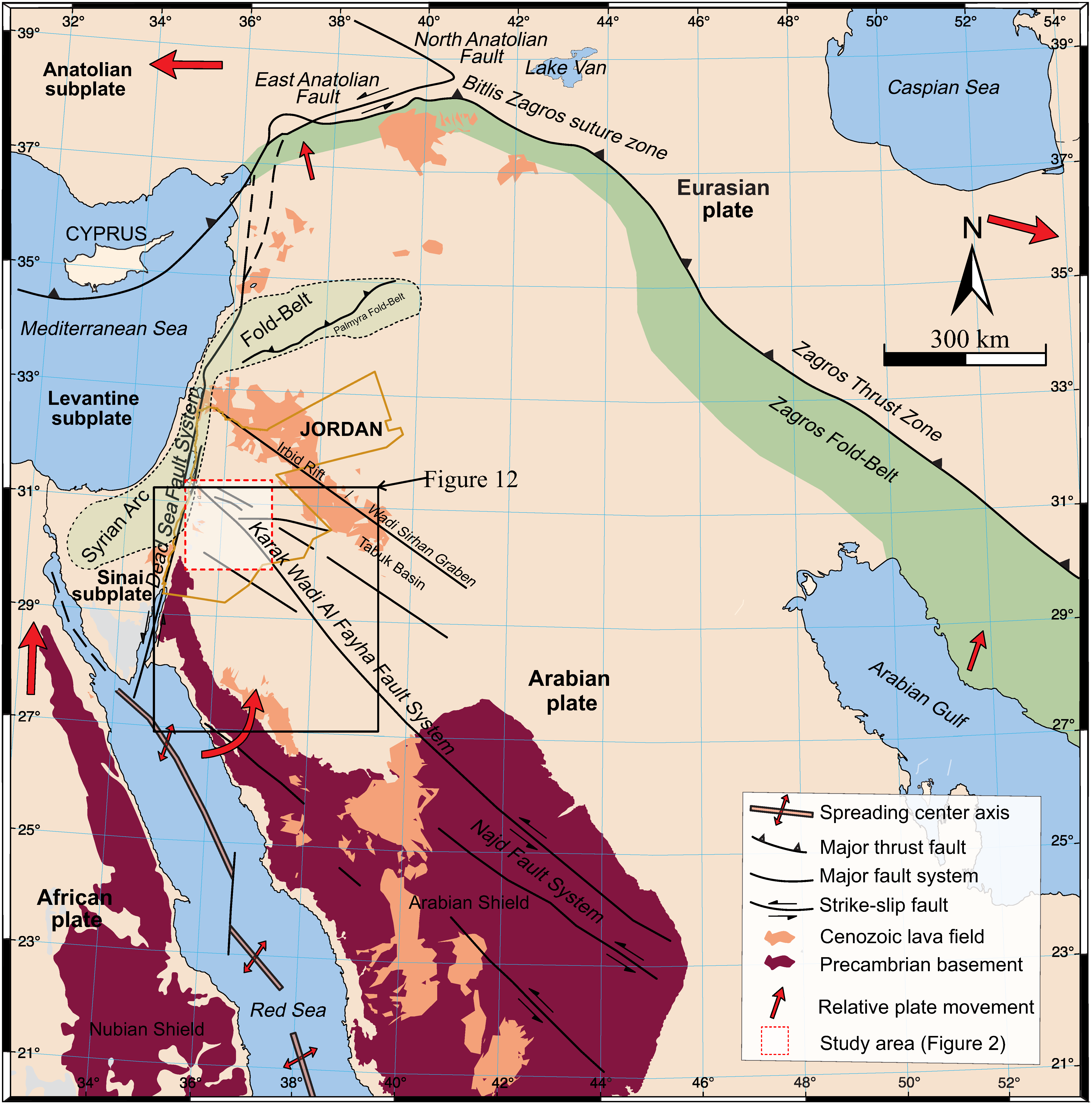
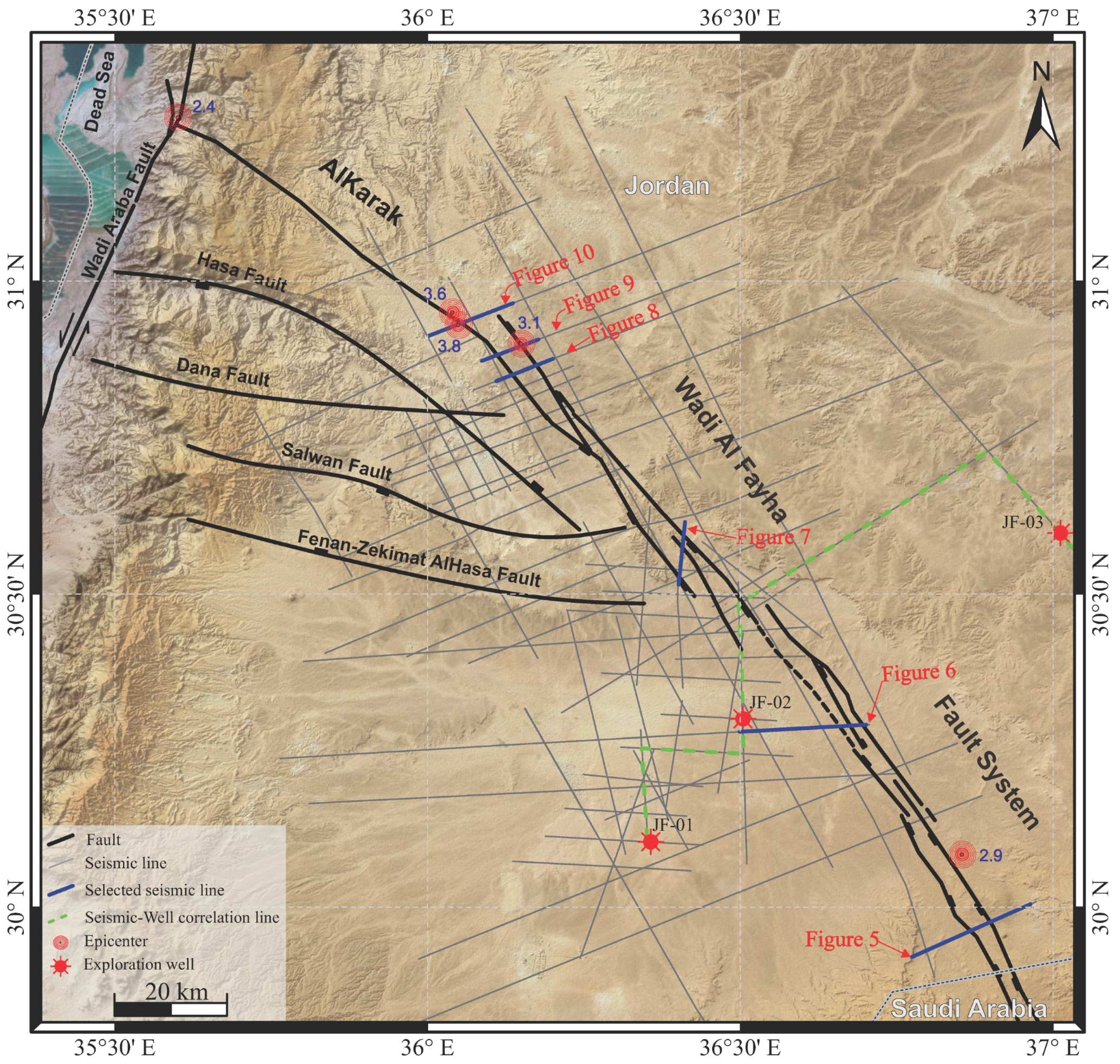
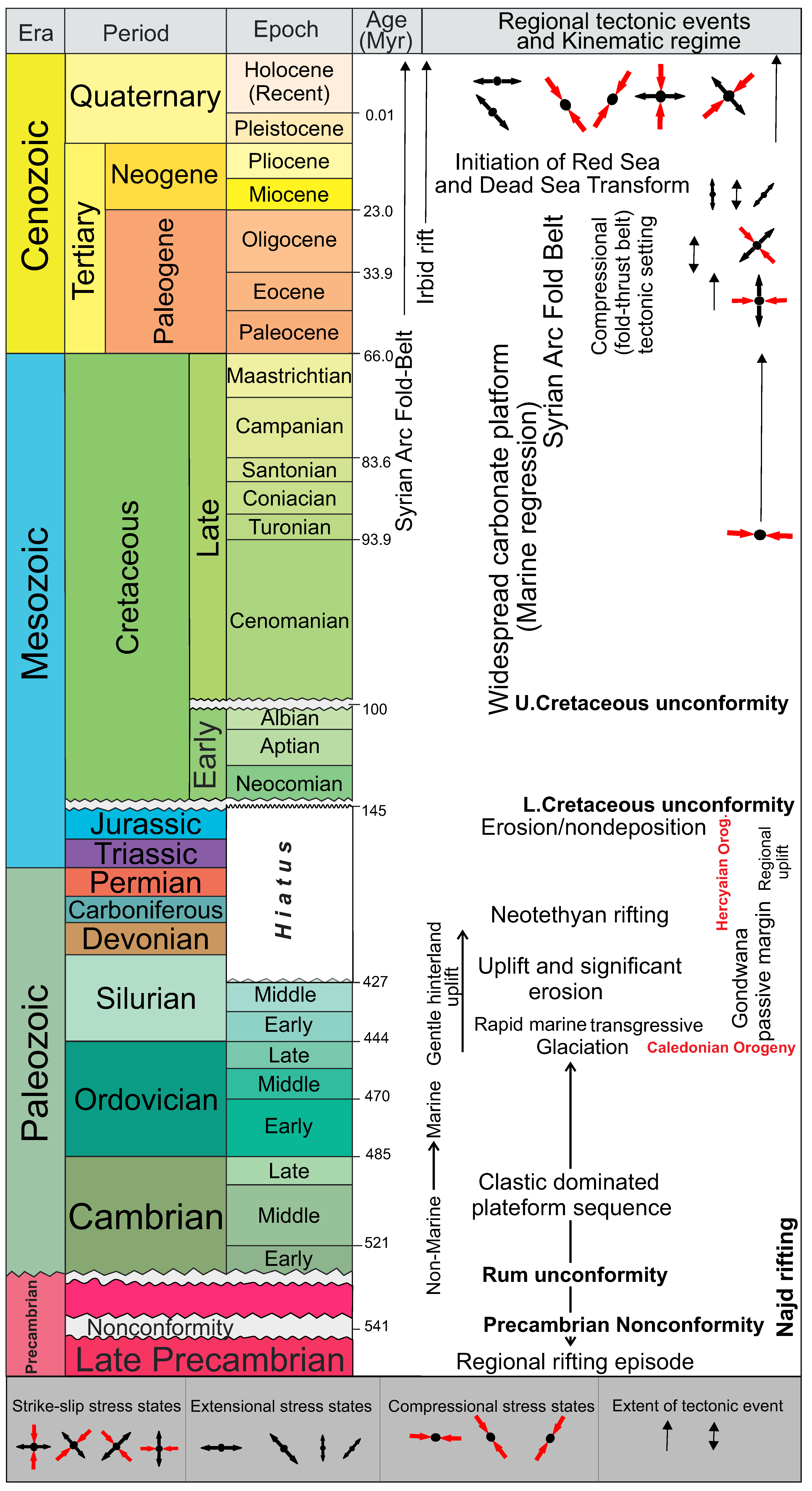
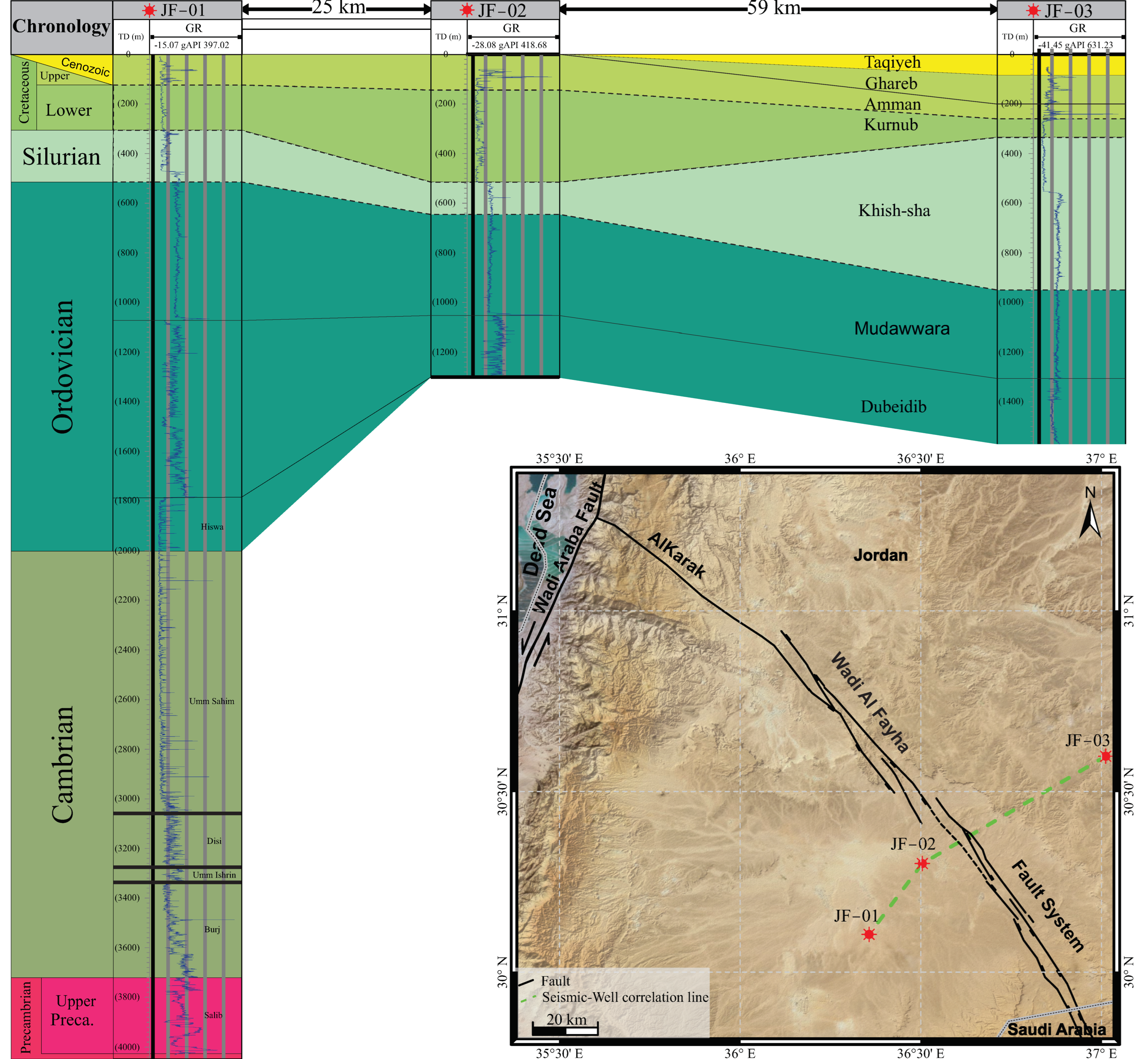

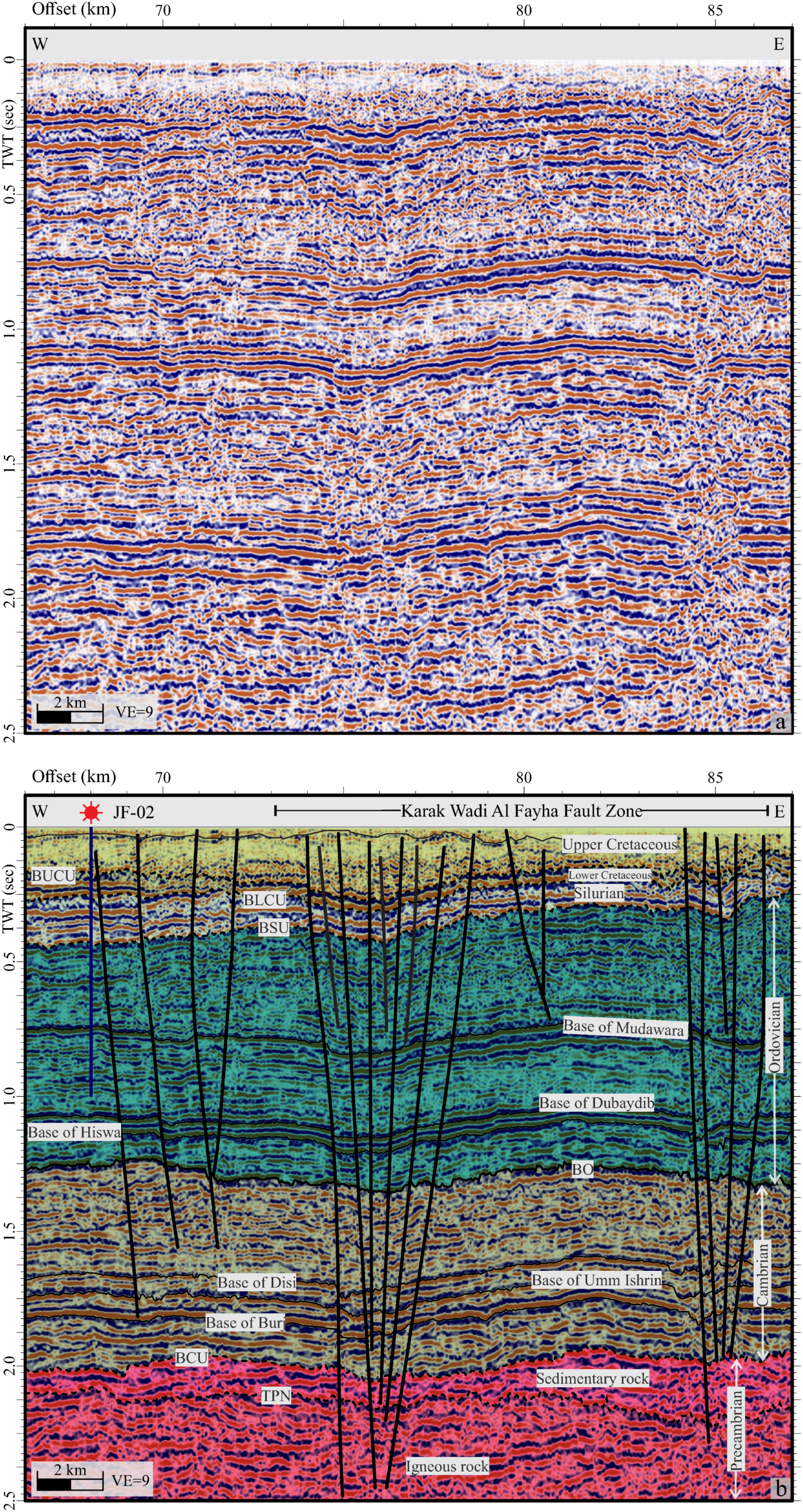
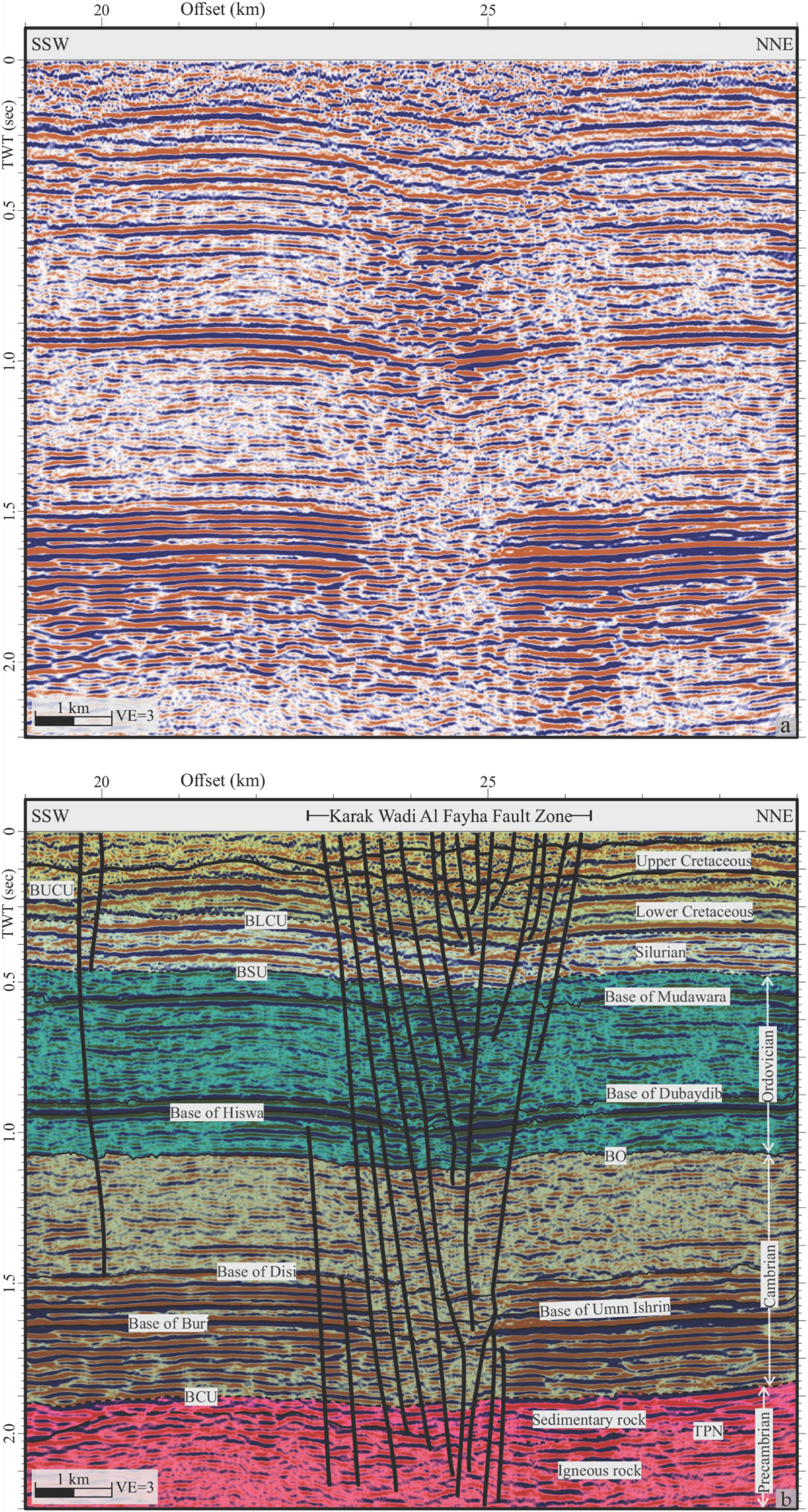
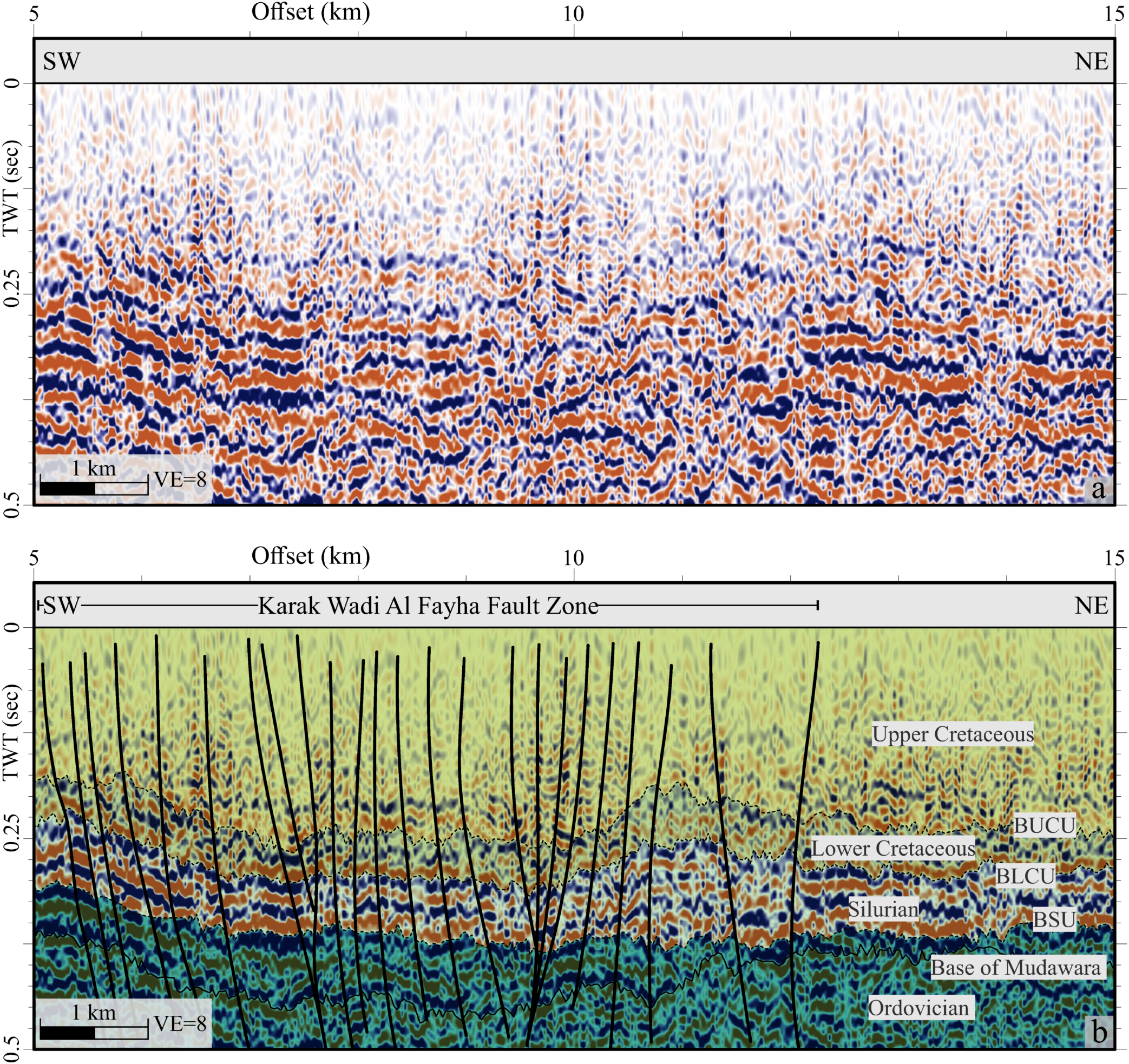
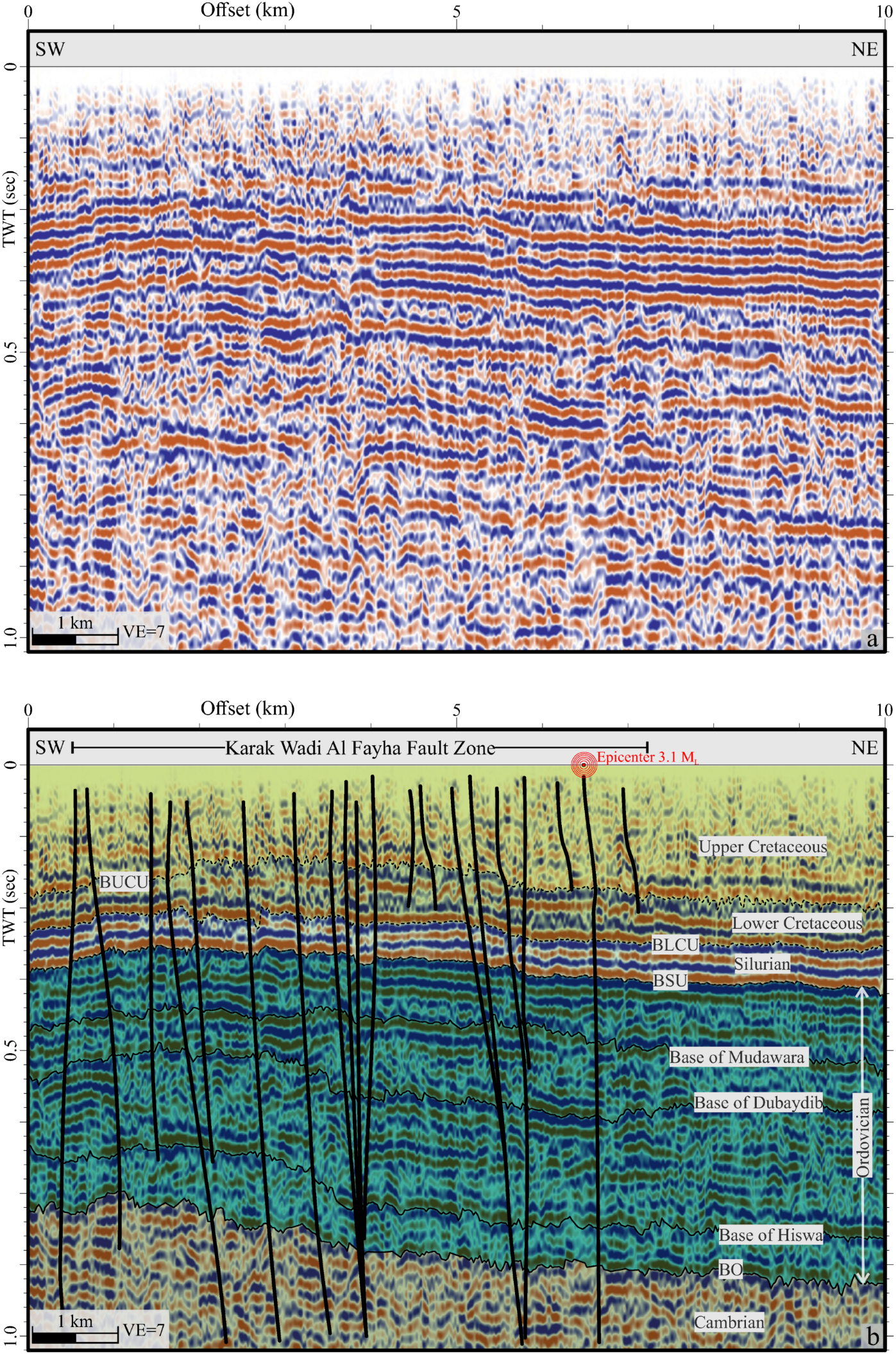
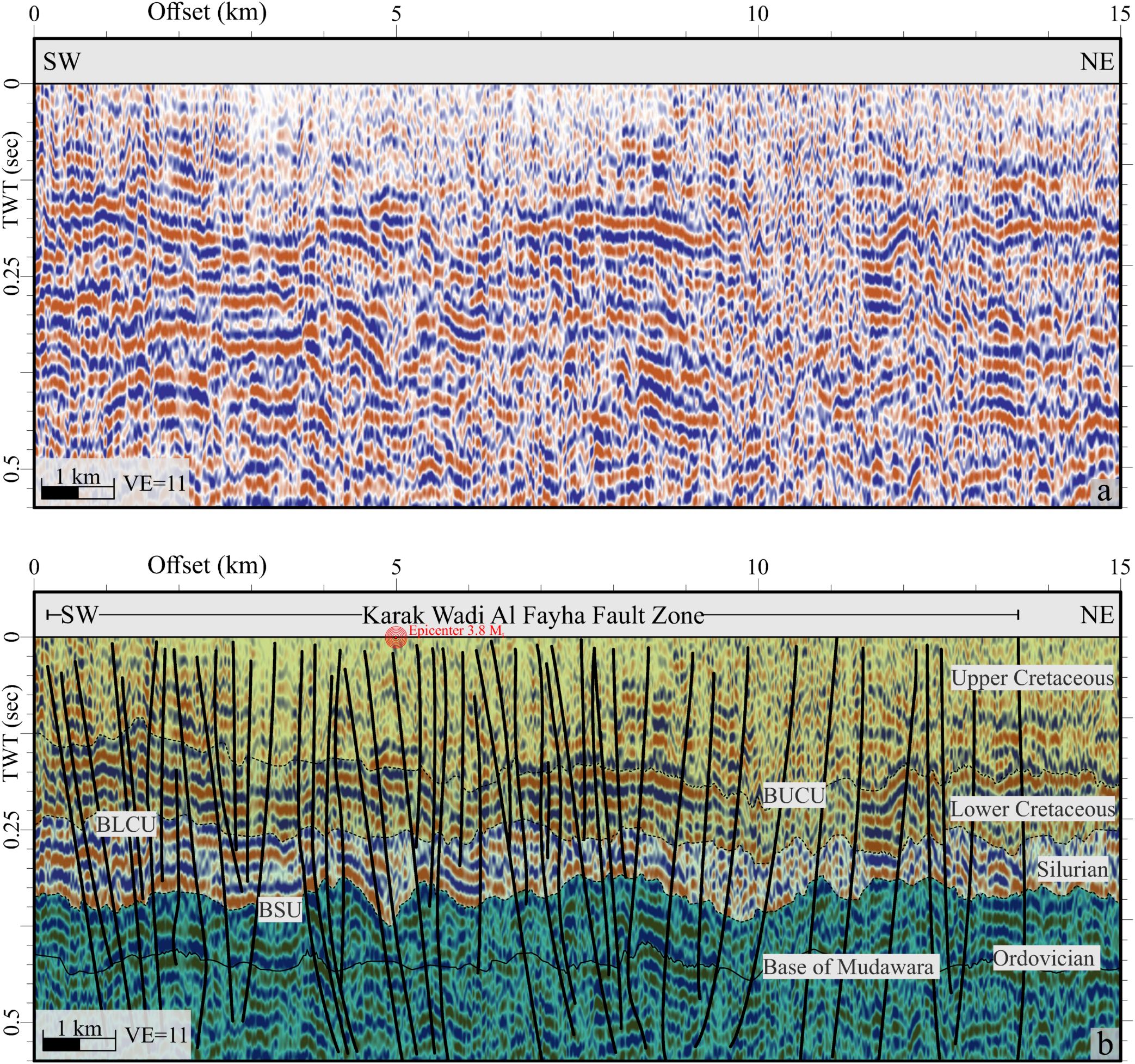

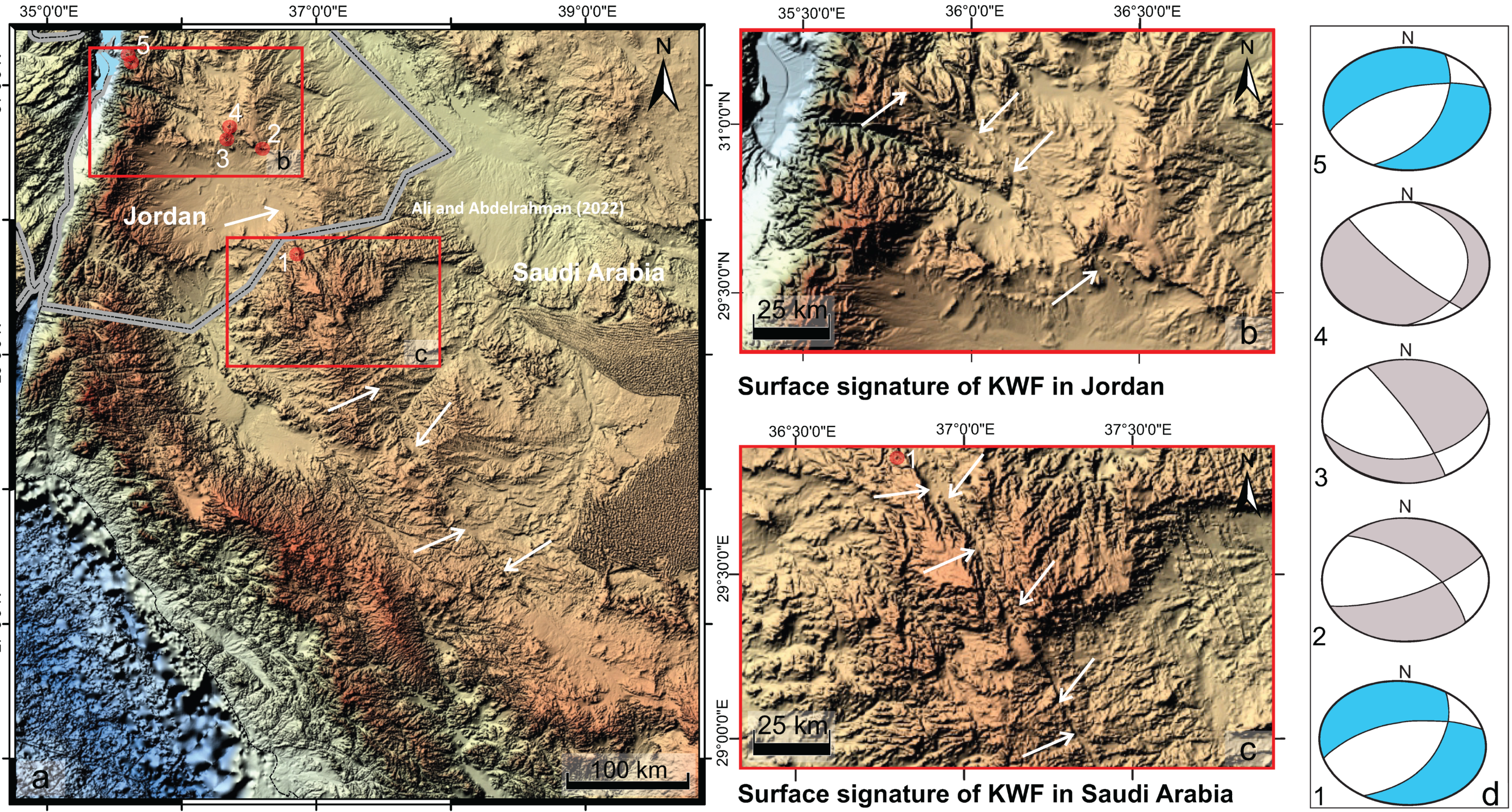
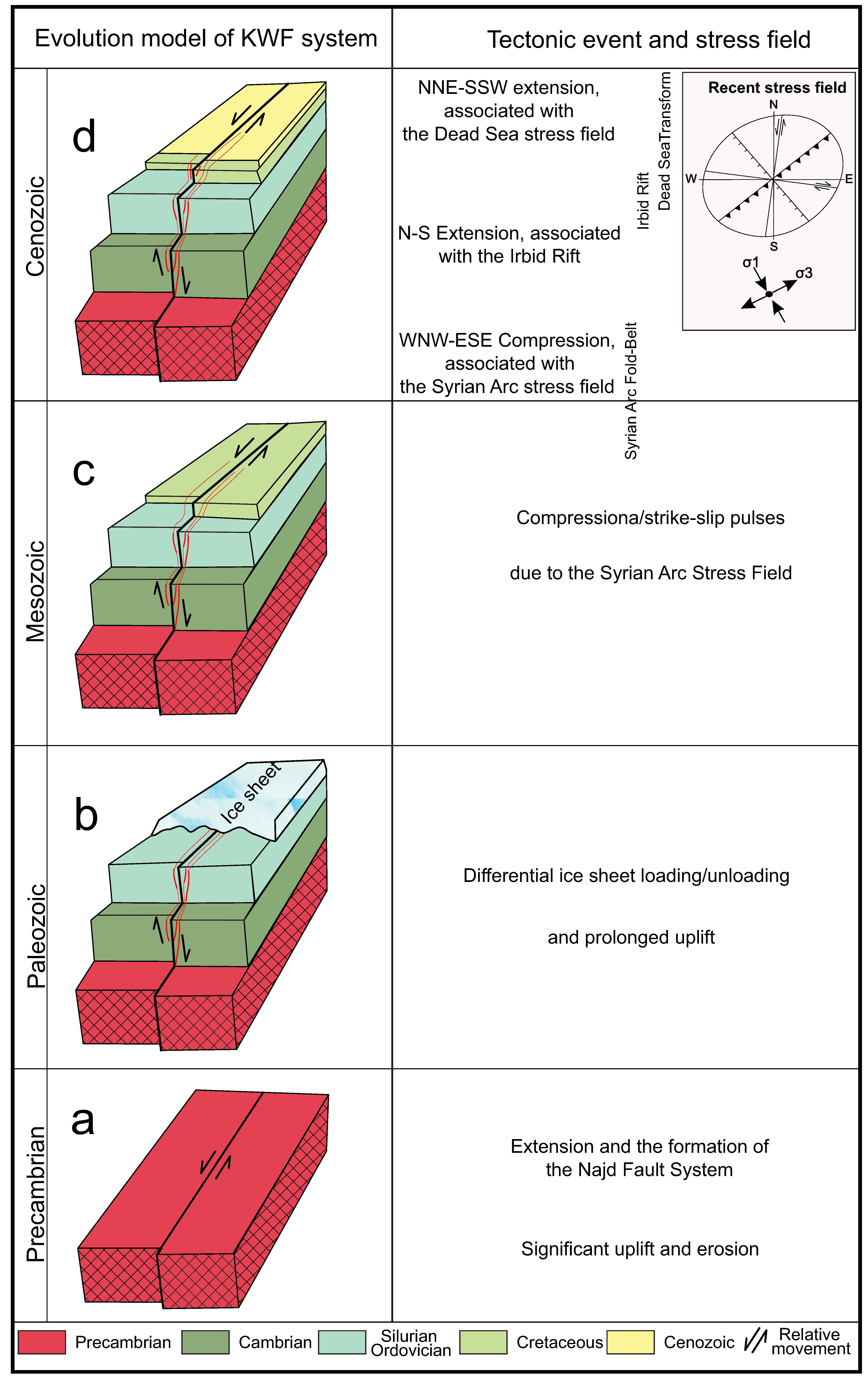

| Pre-processing | Demultiplex Trace muting (top mute) Trace amplitude recovery (exponent 4 dB/s from 0.0 to 2.5 s) Automatic gain control Band pass filter F-K filter |
| Pre-staking processes | Deconvolution (Designature: minimum phase input assumed) Scaling (offset: 201−3750 m) Time: 0−1000 ms) Velocity Analysis (surface referenced) Normal Moveout Correction Datum statics (Datum 650 and 800 m (ASL) Replacement Velocity 2200 m/s) Common depth point/ straight (fold 30 and 40) |
| Post-staking processes | Time-Variant Filter: time (s) → bandwidth (Hz) 0.0–0.6 8−40 1.0 8–45 2.0 8–35 Spiking Predictive Deconvolution F-K Migration Post-migration processes −Trace mixing, Automatic gain control |
| Key horizon | Description | Reflection |
|---|---|---|
| Base Cenozoic Deposits (BCD) | Identified in localized seismic sections and corroborated by JF-03 well data. |  |
| Base Lower Cretaceous Unconformity (BLCU) and Base Upper Cretaceous Unconformity (BUCU) | These major unconformities delineate the shift from Paleozoic to Mesozoic sedimentation. | |
| Base Silurian Unconformity (BSU) | Indicates a regional erosional surface truncating underlying Ordovician units. | |
| Base Ordovician (BO) | Represents the transition to Ordovician sandstone deposition. | |
| Base Cambrian Unconformity (BCU) | Separates the Precambrian Saramuj Formation from the Cambrian sandstone deposit. | |
| Top Precambrian Nonconformity (TPN) | Marks the interface between the crystalline basement and the overlying sedimentary sequences. |
Disclaimer/Publisher’s Note: The statements, opinions and data contained in all publications are solely those of the individual author(s) and contributor(s) and not of MDPI and/or the editor(s). MDPI and/or the editor(s) disclaim responsibility for any injury to people or property resulting from any ideas, methods, instructions or products referred to in the content. |
© 2025 by the authors. Licensee MDPI, Basel, Switzerland. This article is an open access article distributed under the terms and conditions of the Creative Commons Attribution (CC BY) license (https://creativecommons.org/licenses/by/4.0/).
Share and Cite
Al Hseinat, M.; AlZidaneen, M.; Sweidan, G. Analyzing Recent Tectonic Activity Along the Karak Wadi Al Fayha Fault System Using Seismic, Earthquake, and Remote Sensing Data. Geosciences 2025, 15, 177. https://doi.org/10.3390/geosciences15050177
Al Hseinat M, AlZidaneen M, Sweidan G. Analyzing Recent Tectonic Activity Along the Karak Wadi Al Fayha Fault System Using Seismic, Earthquake, and Remote Sensing Data. Geosciences. 2025; 15(5):177. https://doi.org/10.3390/geosciences15050177
Chicago/Turabian StyleAl Hseinat, Mu’ayyad, Malek AlZidaneen, and Ghassan Sweidan. 2025. "Analyzing Recent Tectonic Activity Along the Karak Wadi Al Fayha Fault System Using Seismic, Earthquake, and Remote Sensing Data" Geosciences 15, no. 5: 177. https://doi.org/10.3390/geosciences15050177
APA StyleAl Hseinat, M., AlZidaneen, M., & Sweidan, G. (2025). Analyzing Recent Tectonic Activity Along the Karak Wadi Al Fayha Fault System Using Seismic, Earthquake, and Remote Sensing Data. Geosciences, 15(5), 177. https://doi.org/10.3390/geosciences15050177









